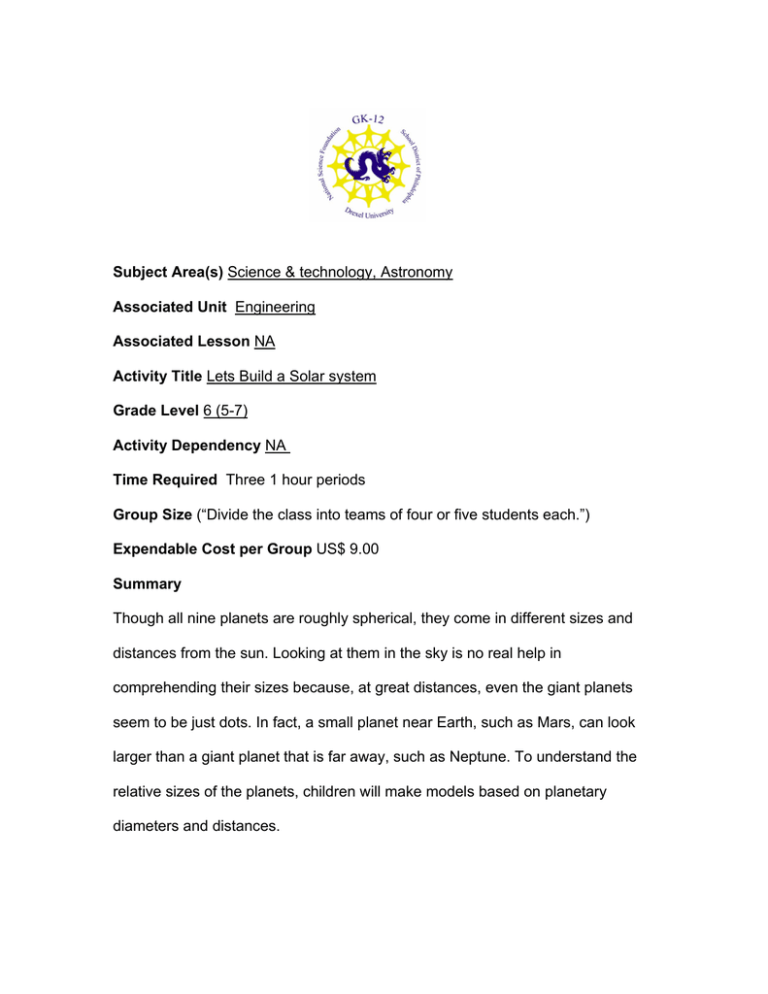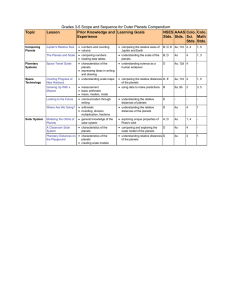Subject Area(s) Associated Unit Associated Lesson
advertisement

Subject Area(s) Science & technology, Astronomy Associated Unit Engineering Associated Lesson NA Activity Title Lets Build a Solar system Grade Level 6 (5-7) Activity Dependency NA Time Required Three 1 hour periods Group Size (“Divide the class into teams of four or five students each.”) Expendable Cost per Group US$ 9.00 Summary Though all nine planets are roughly spherical, they come in different sizes and distances from the sun. Looking at them in the sky is no real help in comprehending their sizes because, at great distances, even the giant planets seem to be just dots. In fact, a small planet near Earth, such as Mars, can look larger than a giant planet that is far away, such as Neptune. To understand the relative sizes of the planets, children will make models based on planetary diameters and distances. Engineering Connection Engineers often use models to represent larger objects in a much smaller area. For example, earlier students built stream tables, which were models of a watershed. Today they will build a model of a solar system. Keywords Solar power, renewable resource, solar cell Educational Standards • Science: • Science: A.1, A.2, E.8, F.3, F.4, F.5, G.1, G.3, E.2, E.1 Pre-Req Knowledge Students should have limited knowledge of the scientific method, as well as the solar system. Learning Objectives After this activity, students should be able to: • Describe the scaling process • Work with scale factors • Describe the characteristics of the nice planets and understand why they are what they are based on planet distances from the sun. Materials List Each group needs: • 1 styrofoam ball • acrillic paint • small diameter metal rod Introduction / Motivation Engineers and scientists use models to represent large objects in a small space. This is done using scaling and scale factors. Vocabulary / Definitions Solar - Referring to the Sun. Definition Procedure • Each student group should select a planet • The students should record the planets distance from the sun as well as its size diameter. • Students should then collect the measurements from other groups • Students will then use the scaling factors to scale down the size of the planets. • Using the same scale students should then scale the diameter. • After the correct size and distance is obtained, students will then paint there planets, as a result of the research they have done on their specific planets. Before the Activity • Gather materials and make copies of the directions that comes with the kit. • The teacher should set up a hot glue gun station so that it does not go everywhere, or students use it for alternative uses. With the Students (suggested subheading) 1. Divide the class into groups of four or five students each. 2. Describe step-by-step procedures. Safety Issues A hot glue gun is needed for this lesson, this should be used by the teacher or teachers aid only. Assessment The teacher should have students write in their log books the lesson objectives from memory. Post-Activity Assessment (suggested subheading) After the lesson the students can make a connection between scaling and what is actually being done by scientists. Owner Rodney Johnson, Drexel University, GK 12 Contributors Sue Slade







